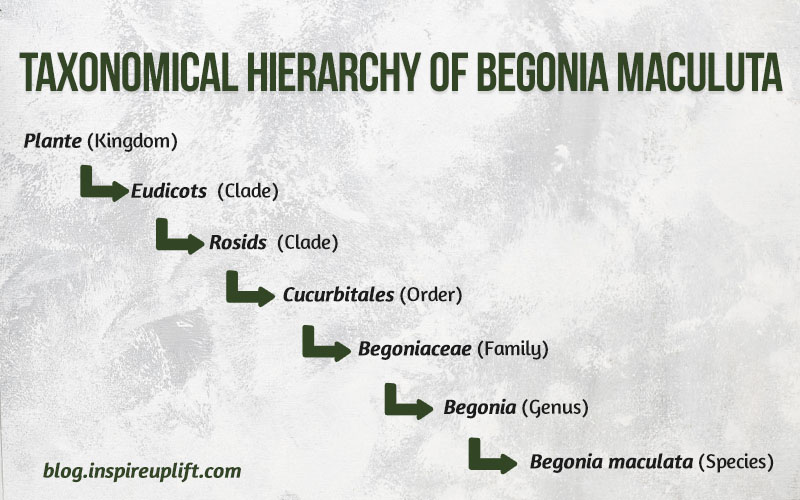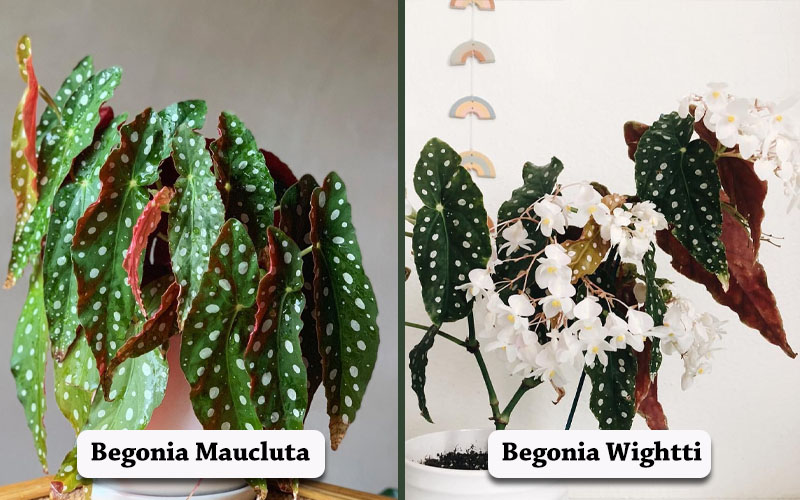Have you seen animals or plants with polka dots on them?
How many so far?
In animals, most common are Leopards and butterflies.
But, what about plants?
Racking your brain?
It’s normal because rarely have we seen plants with such dots.
For this reason, let’s introduce to you one such festive, cheerful and innocent plant, called Begonia Maculata, the leaves of which bear amazing silver polka dots.
So, let’s begin to explore this beautiful indoor plant.

Table of Contents
What is Begonia Maculata?
Begonia Maculuta is an indoor perennial flowering plant species with large angel-like leaves having silver polka dots on them. They are easy to grow and make excellent house plants as long as we pay attention to their cultural needs, like high humidity and partial sunlight.
Their genus, Begonia, has more than 1800 species, of which Begonia Muculata Wightii is the most common one.
Its scientific name is Begonia Maculata Variegata.
Its grouped among cane begonias because of their thick cane-like stem.
Taxonomical Hierarchy of Begonia Maculuta

Characteristics of Begonia Maculata
- It’s perfect to be grown in planters or pots.
- They are from tropical areas where there’s a wet and dry season.
- They can take a bit of drought stress, which is shown in the form of bleach-colored leaves, but come back as soon as you water them.
- The plant does bloom, which means it has beautiful clusters of white flowers.
- The average height they reach upon maturity is 3-4 feet above the ground.
- The good thing about pruning is that it does not require specific pruning tools to cut in any specific way. Instead, you can just cut randomly.
- Begonia Maculata is toxic for cats, dogs, and other pets.
Begonia Maucluta vs Angel Wing Begonia

Some people confuse Begonia Maculata with Angel Wing Begonia, the difference of which must be understood.
Both belong to the same genus but differ in their species type.
Begonia Maculata is one of the begonia species, the scientific name of which is ‘Begonia maculata’,
Whereas,
Angel Wing Begonia is a hybrid of Begonia aconitifolia and Begonia coccinea.
Another difference lies in their flowers.
Begonia Maculata has white flowers, whereas Angel Wing Begonia has pink to reddish flowers.
Nevertheless, because of the angel-like leaves of Begonia Maculata, it’s sometimes also called Angel Wing Begonia, even though it’s another species.
Begonia Maculata vs. Wightti.

Another similar confusion people have is about Begonia Maculata and Begonia Wightii.
Quite interestingly,
The Wightii is not a different variety; instead, it can be called a sub-variety of Begonia Maculata that has white flowers and is the most popular one.
So popular that whenever we mention Begonia Maculata, we mean to say Begonia Maculata Wightii.
With 1800 different species of Begonia, it’s tough to remember every variety, so the most popular are the most known ones.
Other popular varieties are Angel Wing begonia, Rex begonia, begonia Tamaya, Tuberous begonias, etc
How to Propagate Begonia Maculata?
Begonia Maculata propagation is as simple as other plants’. The good thing is, it can be propagated from three different methods, which are:
1. From Stem Cuttings
Stem cutting can either be water-based or direct soil method.
Water Propagation:

In water propagation, simply get a stem that has 1-2 sprouts at least, and dip half of it into the water container.
When the plant’s root reaches half an inch length, it’s time to transport it from water to soil.
It’s not recommended to transport it directly to the soil. Instead, keep putting soil mix spoon by spoon into that water container frequently, until it’s entirely replaced by soil one day.
While doing that, keep the stem hydrated as well.
Now, check it by stretching gently from the top. If it’s firmly rooted, it’s time to transport.
Transportation will be normal.
Fill the 3-inch pot with the same soil mix as you filled in that water container, leaving enough space in the center.
Now, scoop the rooted plant out, making sure the roots are covered and placed at the center of that pot and then cover it with the soil mix.
Water it and place the pot in a warm area.
Soil Propagation:

It is a one-step method.
Simply put the 3/4th part of the cutting into the soil after dipping it in a root hormone powder.
Whatever method you follow, direct soil or water-to-soil, the best thing is to cover the pot with transparent plastic once it is in the soil.
Keep opening it after a day or two while keeping it moist.
2. From Leaf cuttings

Begonia is one of those plants that can propagate well from its leaves as well.
What you need to do is simple.
Pluck 2-3 flowers keeping an inch or more petioles with each of these flowers.
Place a leave upside down flat on a surface. Make a small U shape-cut with a sharp knife at the stem end so that veins are distributed between the leaf and the petiole.
Do this with the other leaves as well, and finally, burry these leaves from the cut-end into the soil.
After six weeks, you will have saplings ready to be moved in a separate pot or elsewhere.
3. From Seeds
To propagate Begonia from its seeds is the hardest of all because Begonia plant seeds don’t have a high germination rate.
Nevertheless, give it a try if you love growing plants from your own seeds.
The seeds can be obtained from an already grown begonia Maculata plant. You may find them at the end of the stems as flowers begin to die.
Take a peat pot or a cardboard egg carton filled with soil.
As a next step, put that container in another big container filled with water.
Now here is the key,
Always water at the bottom, because Begonia Maculuta seeds are so fine that watering from the top will bury them easily.
Now, once the soil is completely moist (exhibiting a dark brown color), break the seed pod and sprinkle the seeds onto the soil.
Here remember,
To avoid the seeds from blowing away,
Put a very thin layer of soil on them.
Finally,
Place this container in a sunny location. In a few weeks’ time, the green sprouts will begin to emerge.
How to Grow Begonia Maculata? (Polka Dot Plant Care)
Growing Begonias are simple for regular gardeners but become difficult for beginners.
So, if you are a novice in gardening, it’s recommended to know the basic gardening tips before you start.
And always use practical gardening tools to avoid damage to the plants and as well as to save time.
So, let’s look at how to grow Begonia Maculata along with begonia Maculata care under each of the heads below.
1. Soil
The soil should be well-drained, but that can hold moisture.
Begonia Maculata grows well if the soil is a mixture of clay, loamy soil, and a bit of sand.
To prevent root-rot, it’s recommended to add a layer of pebbles inside the pot at the bottom.
It’s always recommended to put a soil mess
2. Water
You need to be very cautious while you water this plant.
It’s so sensitive to over-watering that root-rots are sure to happen if you water them more.
Many people complain about its leaves converting to pale yellow color, which is the result of over-watering, just like it happens in the case of Scindapsus Pictus.
If your Begonia goes through the same, just stop watering it until the soil becomes dry and then water it again.
The best practice is to follow the dry-wet cycle. This means, once the soil becomes dry, then only you feed them with more water.
The self-watering hanging basket can of great help here if used properly.
3. Temperature
The temperature required is above 60°F or 15°C.
Keeping them at temperatures lower than this would put them under a lot of stress.
4. Humidity
Polka dot Begonia requires a high level of humidity – about 45% at least.
Such humidity level is difficult to get because our rooms are not that humid in normal days.
So, where would you put it? In the washroom, where humidity is high? Of course not, because such a beautiful plant is worth placing in your living room, bedroom and balconies.
So, use either the humidifier or place a tray of water nearby so that the evaporation produces enough humidity for this plant.
5. Sunlight
These plants really do better if you give them good quality light. So, the Begonia pot should be placed where there’s partial sun, like early morning or afternoon sun.
But, they can also adjust to the full sun if you make them habitual of this gradually. In that case, leaves will change their color to brassy.
So, keep in mind that these plants do need sunlight.
It’s not like you keep them in the corner of your room and expect it to thrive.
6. Fertilizer
As far as the fertilizer is concerned for these plants, we would say these plants grow better if you feed them with fertilizer regularly.
No special type is needed. A normal balanced fertilizer with equal NPK numbers is fine.
Always use some waterproof gardening mat for mixing fertilizer with the soil to prevent the mess.
7. USDA Zone
The USDA zone for Begonia Maculata is 10.
8. Pests
The good thing is, it does not fall prey to any kind of insects.
Common houseplant pests like mealybugs and whiteflies may infect this plant, against which common treatment to manage indoor plant pests work.
9. Pruning
The good thing about Begonia Maculata is, you can chop them off right away from the top without fearing if re-growth would occur or not.
This means if it’s three-feet tall, bring it down to one-foot blindly, and it will regrow.
Common Diseases That May Catch Begonia Maculata
1. Begonia Maculata Leaves Curling

It is the sign of overwatering most of the time – that causes root rot, which means the leaves don’t get enough water and thus curl.
Sometimes, albeit, it can also occur due to under watering or overuse of fertilizer.
2. Begonia Maculata Brown Spots

These brown spots on Begonis Maculata leave means they have the fungal infections called Botrytis, which grows in wet and very cold temperatures.
The first cure is to stop watering it further until the soil becomes noticeably dry.
Second, remove and destroy all the dead parts of the plants that attract any fungus and increase the airflow around it.
Third, use some fungicides for a week or so.
Conclusion
Like different lily types today, Begonia has more than 1800 species, one of which is Begonia Maculata. These are beautiful polka dot plants, with long angel-like leaves and beautiful white flowers.
Try this polka dot plant at home and share with us your experience.

